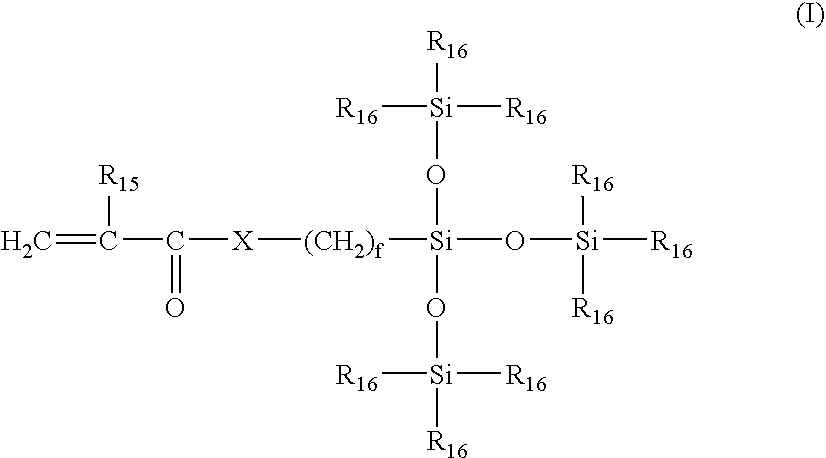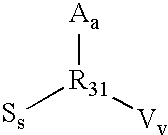Surface modification of contact lenses
- Summary
- Abstract
- Description
- Claims
- Application Information
AI Technical Summary
Benefits of technology
Problems solved by technology
Method used
Image
Examples
example 1
Preparation of an Acid-Terminated Fumaric Prepolymer [(F2D20-diacid)]
[0050] To a thoroughly dried 500-ml round bottom flask equipped with a reflux condenser was added bis-α,ω-hydroxybutyl polydimethylsiloxane (Mn 1624, 30.08 grams, 0.0185 mole) prepared by following a procedure described in Journal of Polymer Science, Part A. 33, 1773 (1995) and fumaryl chloride (MW 152.96, 6.4013 grams, 0.0418 moles) (Aldrich Chemical, Milwaukee, Wis.). The reaction mixture was heated with an oil bath at 60° C. After two hours, the reaction was complete, as indicated by the loss of CH2—OH peak at 3.5 ppm (in H-NMR). The content of the flask was stripped under vacuum (0.4 mmHg) at 80° C. for 2 hours. To the content was then added 3 mg of water and 30 ml of THF. The mixture was heated under reflux until all acid chloride groups disappeared (by IR 1769 cm−1). THF was then stripped from the mixture in a Rotavapor. The residue remaining was then added to 200 mL ether and extracted with 50 mL of water th...
example 2
Preparation of an Acid-Terminated Itaconate-Polysiloxane Prepolymer (I2D20-diacid)
[0051] To a thoroughly dried 500-mL round bottom flask equipped with a reflux condenser is added bis-α,ω-hydroxybutyl polydimethylsiloxane (Mn 1624, 30.08 grams, 0.0185 mole) and itaconyl chloride (MW 166.99, 6.99 grams, 0.0418 moles). The mixture is heated with an oil bath at 60° C. After two hours, the reaction is complete, as indicated by the loss of CH2—OH peak at 3.5 ppm (in H-NMR). The content of the flask is stripped under vacuum (−1). THF is then stripped from the product in a Rotavapor. The residue remaining is then added to 200 mL ether and extracted with 50 mL of water three times. The final residue in ether is dried with magnesium sulfate and then vacuum stripped at 80° C. for 2 hours.
example 3
Preparation of an Acid-Terminated Maleate-polysiloxane Prepolymer (M2D20-diacid)
[0052] To a thoroughly dried 500-mL round bottom flask equipped with a reflux condenser is added bis-α,ω-hydroxybutyl polydimethylsiloxane (Mn 1624, 30.08 grams, 0.0185 mole), 150 mL of tetrahydrofuran and maleic anhydride (MW 98.06, 4.10 grams, 0.0418 moles). The mixture is heated with an oil bath at 60° C. After sixteen hours, the reaction is complete, as indicated by the loss of CH2—OH peak at 3.5 ppm (in H-NMR). To the content is then added 5 mL of water and continued heating for 2 hours. The solution is dried with magnesium sulfate and then vacuum stripped at 80° C. for 2 hours to give product.
PUM
| Property | Measurement | Unit |
|---|---|---|
| Percent by mass | aaaaa | aaaaa |
| Percent by mass | aaaaa | aaaaa |
| Percent by mass | aaaaa | aaaaa |
Abstract
Description
Claims
Application Information
 Login to View More
Login to View More - Generate Ideas
- Intellectual Property
- Life Sciences
- Materials
- Tech Scout
- Unparalleled Data Quality
- Higher Quality Content
- 60% Fewer Hallucinations
Browse by: Latest US Patents, China's latest patents, Technical Efficacy Thesaurus, Application Domain, Technology Topic, Popular Technical Reports.
© 2025 PatSnap. All rights reserved.Legal|Privacy policy|Modern Slavery Act Transparency Statement|Sitemap|About US| Contact US: help@patsnap.com



